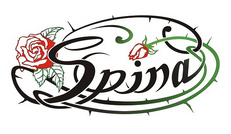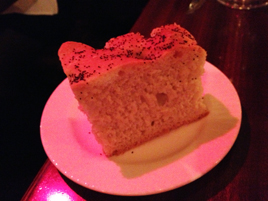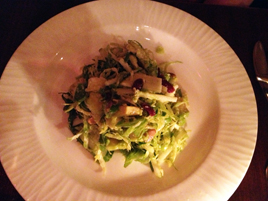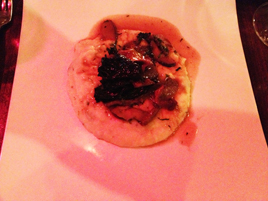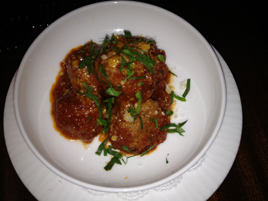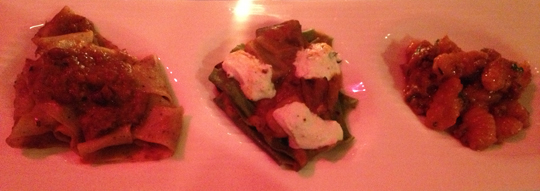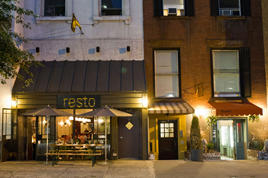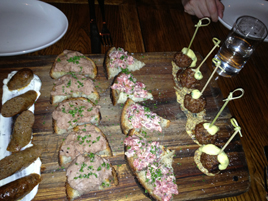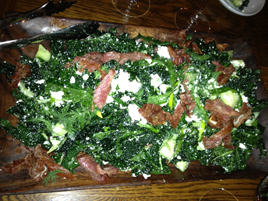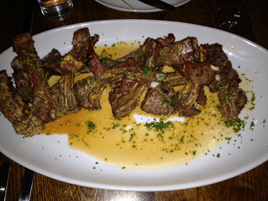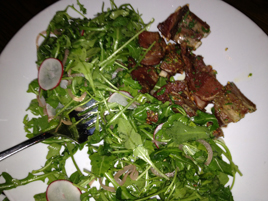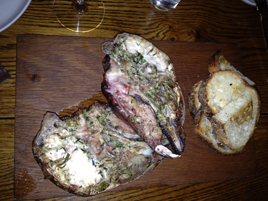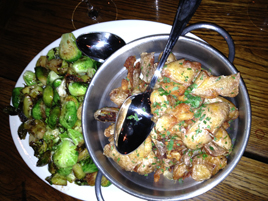Oficina Latina
 Tuesday, March 26, 2013 at 08:58PM
Tuesday, March 26, 2013 at 08:58PM 

 If it were in any other U.S. city, Oficina Latina (opened 2½ years ago) would be one of the funkiest, hippest places in town. In New York, you might imagine that it’s just another Pan-Latin spot that you never heard of, though you would be overlooking its many charms.
If it were in any other U.S. city, Oficina Latina (opened 2½ years ago) would be one of the funkiest, hippest places in town. In New York, you might imagine that it’s just another Pan-Latin spot that you never heard of, though you would be overlooking its many charms.
The décor—really indescribable—is inspired by the Pan-American Highway circa the 1950s. The connection isn’t entirely clear: there’s a pressed tin ceiling recovered from a 1920s bank, various species of mismatched vintage furniture and light fixtures, a barber’s chair at the bar, marble and wrought iron tables, and distressed painted brick walls.
 It’s not fancy or expensive: you can have brunch every day for just $12; add a Margarita or Bloody Mary, and it’s all of $15. Dinner will run you a bit more, but not a lot, with tapas $8–15, soups and salads $8–12, tortas $12–22 (but most under $15), mains $20–23.
It’s not fancy or expensive: you can have brunch every day for just $12; add a Margarita or Bloody Mary, and it’s all of $15. Dinner will run you a bit more, but not a lot, with tapas $8–15, soups and salads $8–12, tortas $12–22 (but most under $15), mains $20–23.
The cuisine is not aligned to any particular Latin-American country: the chef is Mexican, the owners Italian. The publicist (at whose invitation I visited), says the menu is expected to be rewritten shortly: they’re going to shorten it a bit, and make room for rotating specials.
 The bar and cocktail program deserve more exposure. There’s a selection of 100+ tequilas and mezcals, and another 100+ rums and piscos, many offered with custom infusions. A pepper-infused mezcal (right) garnished with a chili pepper was terrific. So was another, made with ancho and lychee.
The bar and cocktail program deserve more exposure. There’s a selection of 100+ tequilas and mezcals, and another 100+ rums and piscos, many offered with custom infusions. A pepper-infused mezcal (right) garnished with a chili pepper was terrific. So was another, made with ancho and lychee.
But the printed menu offers just clichés like mojoitos, piña coladas, and margaritas. The printed specialty cocktails are flavored versions of these (e.g., a blackberry caipirinhas) that sound truly depressing. The beverage director (and co-owner), Paolo Votano, ought to flaunt his better stuff.
While the menu is being re-done, perhaps they’ll improve the plantain chips (above left) that begin the meal: they don’t have enough heft to stand up to the spicy dipping sauce they come with.
But there weren’t many other off-notes to the meal, which showed a kitchen of some accomplishment, especially when it can put the charcoal grill to good use.


Grilled octopus (Pulpo a la Parrilla, above left), served with a cilantro dressing, with a potato and celery salad, had a luscious smoky flavor. There was plenty of warm smoke, too, in tacos with roasted suckling pig (Tacos de Puerco, above right), crackling skin, grilled lime and sliced avocado.


I love blood sausage when it’s done right (Abrebocas, above left), but this preparation was too loose: it oozed out of the casing, like toothpaste, when you tried to cut into it. Chorizo was fine, but unremarkable.
A roasted deboned half-chicken in a garlic sauce (Pollo a la plancha, above right) was tender and full of flavor, probably from that same charcoal oven.


Chili caramelized pineapple (Pina Picante Caramelizada en Agave, above left) was a first-rate dessert, paired with the oddest after-dinner drink I’ve seen: “Passionate Love” (above right), consisting of rum straight-up with lemon wedges that you dip in strips of powdered sugar, cinnamon and coffee, laid out to resemble lines of cocaine.
I can’t comment on the service, since the meal was comped, but the 62-seat dining room was about two-thirds full by 9:00 pm on a Monday evening, so the restaurant apparently has a local following.
I’ve no way of knowing whether the rest of the over-long (and soon-to-change) menu is as interesting as the small sample that we tried. If you order the octopus, the suckling pig tacos, and the chicken, you’ll go home happy.
Oficina Latina (24 Prince Street between Mott & Elizabeth Streets, NoLIta)





















